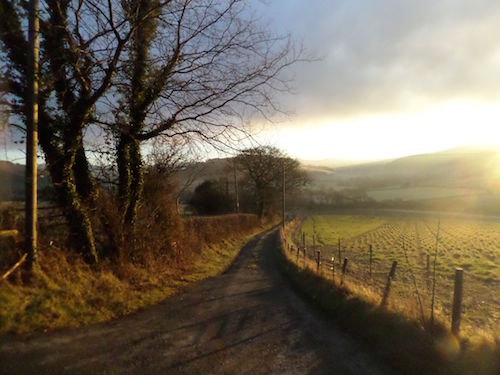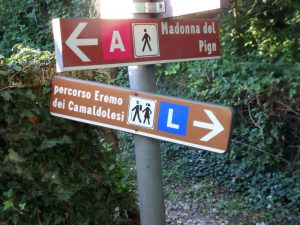For the past couple weeks we’ve looked at physical pilgrimage, especially the Camino de Santiago. Today, my friend Richard Littledale – a pastor, author, and pilgrim – tells us why our faith can be likened to a pilgrimage – a slow, sacred journey taken one step at a time. He introduces this idea in an excerpt from his forthcoming book, Journey. Enjoy!
*****

“Do nothing in haste; look well to each step; and from the beginning think what may be the end.”
These are the words of Edward Whymper, the Victorian mountaineer who was the first European to climb the Matterhorn. Though written well over a century ago, they still ring true – and not just when it comes to climbing. Our Christian life is lived one step at a time – neither more nor less. I have been a Christian for over 30 years and for most of them I have been unable to sing the words of Francis Ridley Havergal’s hymn ‘Take my life and let it be’ without a smile. ‘Take my feet and let them be, swift and beautiful for thee.’
My feet will never be swift or beautiful. However, as a Pastor it has fallen to me to act as a kind of spiritual courier – guiding people from the plains of unbelief, into the foothills of faith, and pointing out the path to the higher slopes of God’s goodness. As I have done this, I have become more and more convinced that this is a journey made on foot – step, by step, by step.
Steps, of course, are so basic that we don’t even have to think about them. From the day we get up off our bottoms and toddle our first upright steps, we never give them another thought. Every step is, in fact, a fall caught just in time. As we walk we transfer our body weight forwards, with front leg bearing the weight. As that front foot strikes the ground, so the knee bends slightly with the impact, bringing the rest of the body almost to the point of overbalancing. This triggers a response in the psoas major of the brain, telling the trailing foot to come around and take the strain in order to avert disaster. With that done, the whole cycle begins again and so we propel ourselves across earth’s surface. On a good day we may perform that cycle of actions over 10,000 times – whether around our place of work or across the wild earth.
To make any journey on foot is counter-cultural in a world where speed is of the essence, and a person may be isolated from their global neighbours by the relative speed of their broadband connection. Few of us walk to work, and walking as a leisure pastime has become part of an expensive and highly technical outdoor sports industry. The idea of a long walk which seems more about the journey than the destination seems alien to our driven and performance-oriented society. Setting out on his journey on foot, journalist Jack Hitt commented that:
What the modern pilgrim is exiled from is not a place but velocity. I haven’t left the world of the city; I have left the realm of the car. What distinguishes me is not that I am out of town but that I am on foot.

In recent years there has been a marked resurgence in the appetite amongst Christians and ‘spiritual enquirers’ of every hue for pilgrimage. In 1985, for instance, 491 people received a certificate of completion on the pilgrim route , or Camino to Santiago de Compostela. In 2010 the number was over 270,000. Amongst those thousands not all are Christians nor even religious. Some walk for the physical benefits, some walk to unravel the threads of a complicated past, and others look for some form of enlightenment. Often it is the journey itself, rather than the destination, which seems to matter most. This is a kind of mobile therapy, where the knots of a tangled and complex life can be unravelled as the miles roll beneath the walker’s feet. Whatever their reasons, ancient pilgrimage routes such as the Camino de Santiago now bear more modern footprints than at any point in my lifetime. This seems like a good time to consider the Christian life as a journey lived at walking pace.
To say that the Christian life is ‘just’ lived at walking pace though makes it sound like an easy thing – as if we can just saunter our way from first calling to heavenly arrival without even breaking a sweat. Anyone who has ever travelled a substantial distance on foot will know that it is not so.

In his youth my father was a very keen walker – travelling great distances between Youth Hostels with his canvas knapsack on his back. Years later, when my brother and I came along, he was still keen to walk. With our much shorter legs we often found it hard to keep up. What was a pleasant stroll to him often felt like more of a route march to us, and I often struggled at the back. Realising this, he took me on one side and explained that the secret to enjoying a long walk was not to concentrate on the distance, but on the contents. In other words, it was better to savour the sights and sounds as you passed through, rather than spending the whole journey thinking about its end. In this way, the miles passed quicker and the journey was a whole lot more pleasant. It is in such a spirit that I write the following chapters.
*****
This is Lisa: I really like Richard’s idea of the Christian faith lived at walking pace. Let’s have a conversation! Feel free to leave comments below.
- Do you agree that in today’s society, walking is counter-cultural, even a form of exile? What does this say about the common idea of Christianity as a “walk of faith?”
- When you consider your own faith journey, do you think of a walk or another form of movement?
- Is the Christian faith about the destination (the end) or the journey itself?